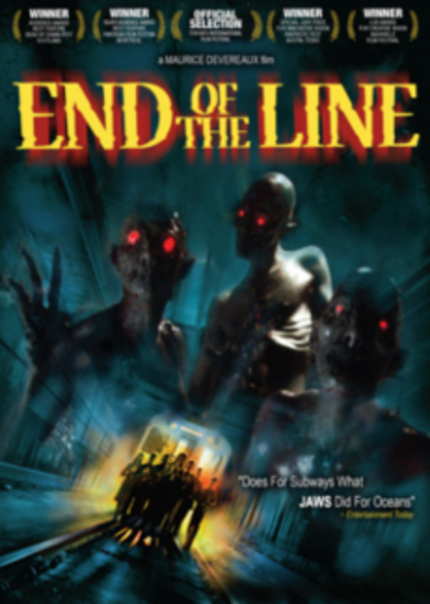DVD Review: Maurice Devereaux's END OF THE LINE

Maurice Devereaux's 2006 apocalyptic horror film End of the Line exchanges familiar antagonists such as monsters, zombies, and serial killers with a different threat: crazed evangelical cultists. This new DVD release includes, among other extras, the question and answer session from the film's 2006 screening at Fantasia Film Festival, an audio commentary, and a documentary about the making of the film. These extras are nice but the main attraction is Devereaux's film, which puts a smart, topical spin on a familiar genre format.
The film introduces the audience to Karen, a young nurse at a psych ward who is having a rough day. The psych ward is full of edgy patients when she gets to work ("I haven't seen this many patients since last Christmas"). Whats more, one of the patients committed suicide on the subway earlier in the day. Karen's bad day continues once she leaves work. A grinning lunatic gets aggressive with her on the subway. A straight-talking rationalist who totes a copy of Carl Sagan's book Demon-Haunted World helps her out. Karen and her new friend board the train, and the assailant gets on another subway car. Among the passengers are members of the Voice of Eternal Hope church, which is led by a John Hagee look-alike named Reverend Hope. The female church members are dressed as if they are ready to hit the pews while the males are clothed in Brownshirt-style uniforms. The lunatic's nefarious actions cause the subway train to stall. During the wait, the church members receive a cell phone/pager message. Soon after, they start murdering subway riders with crucifix knives and swords. A zombie survival scenario arises as Karen and her new friend become part of a small group of strangers who fight their way out of the subway towards the apocalypse that has apparently begun above ground.
End of the Line tightly adheres to genre expectations by effectively delivering suspense, shocks, and gore. Although the film is set in a subway, very little of this HD-lensed film was actually shot on location; CGI is cleverly used to solve some obvious budgetary limitations. The acting is mostly solid, and the contrasts between the various character's motivations and personalities adds tension to the group survival scenario. Overt explanations for key aspects of the story are rarely provided but visual and verbal clues are presented throughout the film. Those who pay attention to the details will, in a manner of speaking, "see the light." The film's tone wavers between horrific and humorous. For example, the mad cultists are presented in an exaggerated style but this does nothing to diminish sense of danger. Anyone who has been approached by a strange pamphleteers at the door of their homes, on the street or in a subway should be able relate on some level to this. Whereas a mixed tone might be seen as a lack of commitment, a balance of laughs and shocks is par for the course in horror films. In fact, outrageous elements, such as wonderfully disturbed "family portrait" that occurs in the third act, simultaneously summon feelings of horror and humor.
What gives End of the Line its edge over similar films is its riffing on common notions that the world is perpetually on the verge of a prophesied apocalypse, perhaps with a bit of nudging by the faithful. These ideas are not isolated to Christian-rooted systems but are increasingly spread throughout Western culture in the form of evangelically-oriented books (Left Behind and The Omega Code) and movies that present these concepts in familiar and digestible form. In fact, its not much of a stretch to view End of the Line as an inversion of this approach because it uses a very standard, and perhaps overly comfortable, genre framework to communicate some skeptical ideas about religious beliefs, and the willingness to act on those beliefs in certain circumstances. Although the film is inherently skeptical towards the subject, there is no "preaching" and the characters express multiple views of why the events portrayed in the film are taking place. Ultimately, the narrative clearly points down the path of doubt.
End of the Line successfully delivers a film that meets expectations of horror fans while slyly mixing in a skeptic's perspective on religious extremism. The use of the format to play with such concepts is smart, and is largely responsible for placing End of the Line ahead of a crowded field of horror films.







